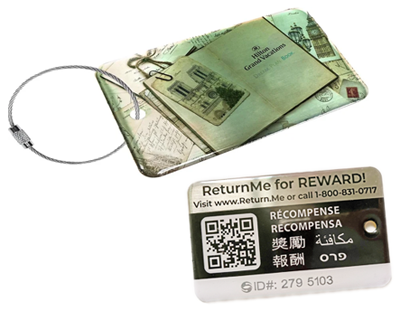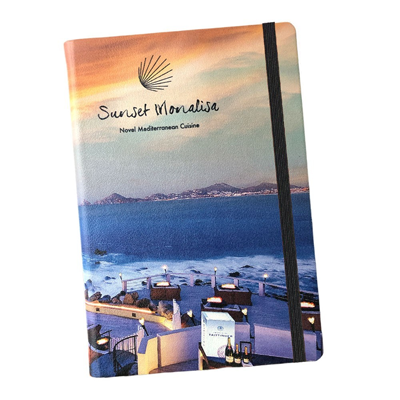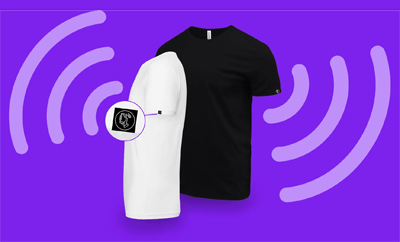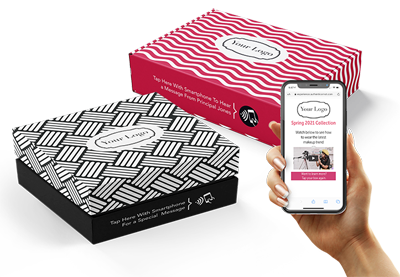The best promo creates a lasting and memorable experience. In addition to thoughtful color choices and decoration options, adding interactive technologies like QR codes and NFC chips to branded items – especially those intended to be used over and over – can take a campaign to the next level.
“It’s definitely something we’re seeing a lot more of lately,” says Lauren Smith, brand merchandiser for Boundless, based in Texas and No. 14 on the PPAI 100 ranking of the industry’s top distributors. “I think it’s such a great aspect to add to a product, because then you’re able to bring that end user and take them back to whatever landing page that you want, whether it’s a landing page to talk about your brand, or it could be a learning page to talk about that specific item and maybe the back story of where the item was made and what it’s all about.”
In addition to the storytelling potential, tech features in and of themselves have high perceived value with end users and add a gee-whiz factor that can set your campaign apart from the rest.
“People are always impressed by new technologies, by something as simple as an NFC chip, something that doesn’t require energy, so the wow factor is always going to track more, and it’s going to bring more attention to your business,” says Paul Stewart, sales and customer service manager for Houston-based supplier Travel Diary.
QR Codes: Tried And True
Quick response codes have been around for about three decades. They were first invented and used in 1994 by a subsidiary of Toyota as an internal tracking system during the manufacturing process. The codes saw their first widespread public use in Japan in 2002, but they didn’t become popular until 2011, after QR code scanners and readers were made available for smartphones.
The codes fell out of favor within a few years, but then the pandemic made them a big deal again, as businesses needed touchless ways to engage with customers. Survey data from September 2020 shows that about half of respondents had noticed an increase in QR code use since March of that year, when many stay-at-home orders took effect, and very few respondents (less than 14%) said they had never scanned a QR code.
“Everybody’s using them nowadays, and honestly, I think COVID had a big part in that, because when you would go to restaurants, people moved away from physical menus, and you’d have to scan a QR code to get that that menu,” says Adam Abdulrahman, director of sales and operations for Montreal-based supplier ReturnMe. “I think because of that, people became a lot more comfortable with it, more familiar with it, so we noticed a lot of people more willing to use it now.”
Now that QR codes have become more familiar and widely accessible, with the capability to read and access them built into most smartphone cameras (85% of Americans now own a smartphone), this interactive option is here to stay. In fact, approximately 89 million Americans scanned a QR code in 2022, up by 26% compared to 2020 and still growing.
Advantages And Disadvantages Of QR Codes For Promo
In addition to their familiarity and ease of use for end users, QR codes are easy to generate and can provide tracking, a key advantage for marketers and brands. Opt for a dynamic QR code (as opposed to static) for the ability to track when and where the code is scanned and how many times, as well as the operating system of the device used (e.g., Apple iOS or Android, etc.).
Another advantage of dynamic QR codes is that, as the name implies, they can change. This makes it easy to update the destination URL, for example, to keep users interacting with promo items bearing a code. But keep in mind that QR codes can be scammed or hacked, so it’s important to keep an eye on the usage data to protect your end users and your brand.
QR Code Best Practices, Example Use Cases
Make sure to continuously update the destination content so it provides something that is useful and interesting over and over again. You don’t want to direct users to a page that never changes, says Kaylee Shields, business development specialist with Image Masters, a distributor based in California.
“I don’t think it makes sense to have just a stagnant website that every time you scan it, it’s the same thing again, unless you’re using it for the means of a restaurant where you’re pulling up a menu,” she says.
One common practice is to use QR codes as a paperless way to make event materials available at a conference, as PPAI does. But QR codes can be used in almost any scenario, from the ubiquitous “scan for more” appearances to a reusable fast-food or theater cup that reveals a new coupon each week.
ReturnMe uses QR codes on its customizable tags designed to help restore lost items – keys, luggage, etc. – to their owners. Each tag bears an ID number registered to its owner, who can go online and update their contact information as needed. Scanning the QR code on the tag makes it easy for someone who has found an item to report the find.
This helps keep the service confidential, protecting the privacy of both the finder and the owner, says Abdulrahman. “We always act as the middleman, and we obviously don’t share their information.”

Customize a Return Tag for luggage, keys or pets in stainless steel with a domed epoxy finish or durable PVC. Includes full-color, photo-quality printing on the front and return information (including QR code) on the back, as well as a double-sided 8×3-inch marketing card, stainless steel loop and lifetime service. Gift box or greeting card presentation also available.
ReturnMe / PPAI 362853, S2
NFC Chips: New(ish) Kid On The Block
If you’ve used tap to pay, you’ve used near field communication, or NFC. Although the technology has in development since the days of Thomas Edison and the radio, it didn’t become widely available until this century, when contactless payment systems emerged in the early 2000s. Now, NFC chips can be used to make almost any object “smart” and able to share data wirelessly.
The technology requires a microchip, which acts as both transmitter and receiver, as well as a reader that scans the chips to access the data. Although most smartphones now feature NFC capability, it’s not quite as widespread or familiar as QR code access and may require the user to adjust system settings.
Advantages And Disadvantages Of NFC Chips For Promo
While QR codes have to be printed, which can dominate or interfere with branding and decoration, NFC chips allow a more subtle approach. Because NFC tags are physical objects, as opposed to a printed decoration, they can be concealed with added elements like a book’s binding, a bottle cap, a seal or sticker, etc.
“It serves the same purpose as a QR code, but from a design aesthetic, you don’t have to see the code,” says Michelle Harris, owner and “controller of chaos” of karstpromo, a distributor based in South Carolina. “That’s kind of cool, and it has that cool factor to it – you just wave your phone over it, and there it is.”
NFC technology offers the same key advantages as QR codes:
- It enables interactive experiences with little effort, so users can access branded content or perform actions with just the tap of a phone.
- Access to information is always at hand, with no web searching needed.
- Usage is trackable, so marketers and brands can analyze preferences, usage patterns and other consumer data to help refine their product offerings and marketing campaigns.
“NFC is not only going to be something interactive with your customer, but at the same time we are building a platform where you can get data out of all the interactions that are built through the chips,” says Stewart.
“For example, now you can know where the chips are being scanned for geolocation. You can know the amount of interactions people are having through the NFC chips or what device they’re using, or the operating system, if it’s an Android or an iOS,” he adds. “It gathers information on how they’re being used, so it gives you more data on the advertising value of the piece. It’s really amazing the amount of information that you can get out of it.”
Lack of familiarity among buyers and their end users is a potential limiting factor, and NFC chips still run anywhere from $2-$5 per item, which can be a deterrent to price-conscious buyers – not to mention the ongoing effort required to plan, execute and update the linked content.
“There’s a lot of ways that, from an integrated marketing viewpoint, you could definitely make it amazing,” says Shields, but she cautions that it requires an ongoing commitment from the brand providing the chipped items. “To make NFC really worthwhile, you have to have a marketing team behind it that is making it worthwhile.”
Another limitation of NFC is that the chip and reader must be in close proximity for successful communication. Also, with respect to promo products and decoration, it can be tricky to find the right construction for protecting the chip with just enough of a layer that will secure it without preventing data transmission.
Cybersecurity is also a concern, as a hacker could manipulate or corrupt the linked data, or potentially gain access to an NFC-enabled device.
NFC QR Code Best Practices, Example Use Cases
As with QR codes, it’s important to keep NFC-linked content fresh so users have a reason to keep interacting with the chipped item. Update regularly with promos, discounts, personalized messages, even games. Static information like product details, user manuals, or the origin story of the item is also valuable via NFC.
“I think the exciting thing about it is that there are probably a lot of use cases for it, and some we just haven’t seen yet,” says Rebecca Klapper, manager of brand marketing and communication for Boundless. “I think that you could probably direct people to a game that captures their information or leads. There are, I think, a lot of ways to gamify a lot of promo that we’re seeing and doing.”
Get familiar with NFC technology and what it can do, she adds, because if you (and your clients) don’t understand it, you might not recognize how best to use it.
“If you know how to use it to bring somebody and keep that personalization throughout their journey using the technology, then I think you’re going to see the best success with it,” Klapper says. “It’s going to feel tailored towards them, and I think that’s the goal of the technology.”
Potential use cases abound, from a welcome kit for new employees that features a chipped item with important HR information to games that help a brand gather user-generated content on social media. Travel Diary, for example, offers NFC chips as an add-on option in its journals, keychains, business cards and more.
“The way that we’re implementing the NFC chips in the promotional industry is aimed at creating a more interactive experience with the brand, meaning that you’re going to share an experience with your customer through a promotional item,” says Stewart. “It can lead to a website, it can lead to maybe a coupon, maybe a video, business card information – or it can even do instant payments.”
A restaurant chain bought Travel Diary journals with an NFC chip on the cover that directed users to a coupon in a campaign so successful that they ordered more. Another project for a real estate company gave agents a journal they could use to take notes as well as scan to access the latest listings.
Here are a few promo products currently available with NFC chips:

Add an NFC chip to a Custom Professional Journal, embedded in the cover or enclosed in an added PVC emblem on the elastic closure (available in 12 colors). Cover options include debossed vegan leather, UV print or full-color photo, and the 80 pages inside can be customized with your client’s brand as well.
Travel Diary / PPAI 737390, S3

The TAP Tee features an NFC chip in the left sleeve hem that can be tapped with a smartphone to launch a website, app, video or social media post programmed with whatever your client wants. Made of 100% sustainably sourced, combed, ring-spun cotton with a tear-away label, it’s available in black or white and sizes XS-4X. Examples at The PPAI Expo 2023 included a T-shirt for the Barbie movie, where scanning the sleeve took users to the trailer. Another potential use could be shirts for sports fans with a chip programmed to share the schedule and stats of the team, or messages to fans from the players.
Threadfast Apparel / PPAI 622344, S6

Don’t forget about presentation! Smart Boxes contain NFC technology so you can design one or multiple customized, digital experiences to engage the end user with a simple tap of their smartphone to the box. Create videos, share special offers and even collect feedback. NFC chips available in soft-touch boxes, corrugated boxes, keco boxes or pillow pods.
Keepsake Products USA / PPAI 634695, S4
Selling Interactive Promo Tech Options
Interactive promo can be accomplished with anything from a sheet of stickers to customize your water bottle all the way up to an embedded NFC chip to scan for the latest and greatest from the brand. Choosing the right approach depends on what your client’s audience will do, what they’re willing to invest in the item and campaign, and what the technology will support.
Because of the cost and because NFC is not widely used in consumer products just yet (other than tap-to-pay credit cards), it’s something that you have to push on, says Harris.
“You have to educate the clients and really show it as an option and sell it, show them how they can use it,” she says.
Harris says she has been using QR codes and augmented reality elements in promo projects for a long time, and now she’s working on a self-promo campaign that incorporates NFC to show off what can happen with it.
And, of course, it takes time – a luxury any distributor can tell you is in short supply – to plan for truly outstanding promo. Harris says cost comes second to time as the main reason why she doesn’t do more projects with an NFC element.
“They haven’t given us or them enough time to do the creative, cool things in the right way,” she says. “And when you’re trying to make sure that things look great and that it actually makes sense to do something like that, it takes a little more time.”


